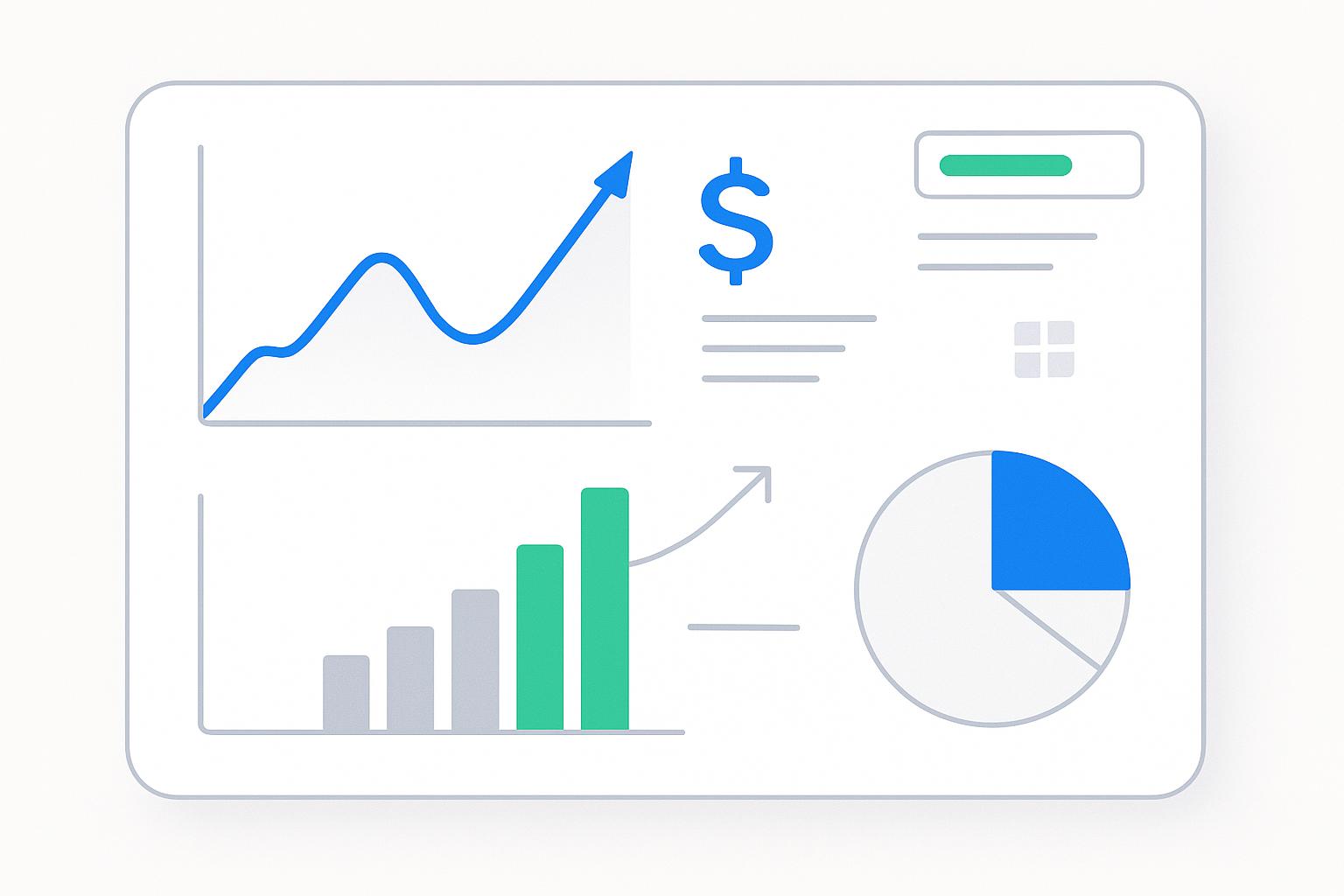AI tools are transforming financial planning by making budgeting smarter, faster, and more accurate. They simplify scenario-based planning, help predict trends, and allow businesses to adapt to market changes. Whether you're a startup or an established company, these tools can save time, reduce errors, and improve decision-making.
Key Benefits of AI in Budget Planning:
- Automation: Reduces manual work and errors by up to 90%.
- Real-Time Insights: Tracks finances live and adjusts forecasts instantly.
- Scenario Flexibility: Models outcomes for growth, expansion, or downturns.
- Tool Examples: Lucid Financials (startups), Anaplan (large enterprises), Zeni (small businesses).
Quick Comparison of AI Budgeting Tools
| Tool | Best For | Key Features | Pricing |
|---|---|---|---|
| Lucid Financials | Startups | Scenario planning, QuickBooks integration | Free & low-cost |
| Anaplan | Medium to large firms | Sales integration, enterprise modeling | Subscription-based |
| Zeni | Small businesses | Automated bookkeeping, compliance tracking | Flat fees |
AI-powered tools are reshaping financial planning by making it easier to forecast, track, and adjust budgets for any scenario. Read on to find the best tool for your business needs.
Advantages of AI in Scenario-Based Budget Planning
Automated Financial Models
AI simplifies the creation and maintenance of financial models, cutting down on manual work and reducing errors. For example, IBM Planning Analytics helped a tech startup automate its financial modeling process. This included tracking sales projections, development costs, and marketing expenses. By using automated insights to pinpoint underperforming marketing investments, the startup was able to tweak its strategy and avoid major losses [1].
Modern tools like Lucid Financials take it a step further by seamlessly connecting with platforms like QuickBooks and payroll software. They process financial data automatically, keeping models up-to-date and allowing businesses to adjust scenarios without needing manual updates. This level of integration makes scenario planning much faster and more efficient.
But automation is just the beginning - AI also uses real-time data to elevate financial planning.
Real-Time Data and Forecasting
AI tools continuously monitor key metrics and update forecasts as conditions change, unlike traditional methods that rely on periodic updates. For instance, Anaplan provides instant insights by dynamically adjusting to market shifts [1].
An e-commerce startup used Anaplan's real-time integration to sync sales and marketing data. This enabled quicker, data-driven decisions about inventory and resource allocation. Real-time forecasting like this gives businesses the agility to adapt their plans on the fly.
Scenario Planning and Flexibility
AI processes numerous variables to create projections for different business scenarios, such as steady growth or rapid expansion. Its advanced analysis capabilities provide detailed insights tailored to each scenario.
| Scenario Type | AI Capabilities | Business Impact |
|---|---|---|
| Conservative Growth | Reviews past trends and market signals | Helps maintain stable cash flow and identify savings |
| Rapid Expansion | Estimates resource needs and spending patterns | Supports strategic funding and resource allocation |
| Market Downturn | Tests financial models under stress conditions | Aids in creating contingency plans and minimizing risks |
With the ability to quickly adjust forecasts, AI ensures businesses can respond effectively to changing market conditions, seizing opportunities or mitigating risks as they arise.
Essential Financial Planning Tools and Skills for Startup Founders
Leading AI Tools for Scenario-Based Budget Planning
AI tools are changing the game for financial planning, giving startups and SMBs the tools to adjust to shifting scenarios with ease. Here’s a closer look at three standout platforms that are reshaping how businesses handle budgeting and financial strategies.
Lucid Financials

Lucid Financials blends AI-powered scenario planning with industry benchmarks and collaboration features to simplify financial management. Designed for startups and SMBs, it supports teamwork through shared workspaces and tools tailored for hiring, fundraising, and investor reporting.
| Feature Category | Capabilities |
|---|---|
| Financial Planning | AI-generated plans, scenario planning, industry benchmarks |
| Integrations | QuickBooks, payroll systems, bank connections |
| Team Collaboration | Multi-user access, shared workspaces, investor reporting |
| Scaling Tools | Hiring plans, fundraising tools, board updates |
Anaplan

Anaplan stands out for its collaborative financial planning capabilities, built on a cloud-based platform. With AI-driven insights, it integrates sales and marketing data to create flexible financial models that respond to market shifts. This makes it a go-to for businesses with more intricate financial setups.
Zeni

Zeni focuses on automating bookkeeping and providing real-time cash flow insights. It also handles compliance tracking and financial reporting, ensuring precision and clarity. Its AI-driven tools simplify expense management, making financial operations smoother and more efficient.
These platforms cater to different needs in financial planning. Lucid Financials offers a broad range of tools for scaling and planning, Anaplan excels in collaborative forecasting, and Zeni specializes in automation and compliance. Evaluating their features can help businesses pinpoint the right fit for their goals.
sbb-itb-17e8ec9
Comparison of AI Budgeting Tools
Features and Benefits
AI budgeting tools cater to various business needs, offering specialized features to tackle challenges like scenario-based budgeting and workflow automation. Here's a quick breakdown of what each tool brings to the table:
| Tool | Key Features | Ideal For |
|---|---|---|
| Lucid Financials | Tools for growth planning and fundraising | Startups needing scalable solutions |
| Anaplan | Enterprise modeling and sales integration | Medium to large businesses |
| Zeni | Automated bookkeeping with a focus on compliance | Small businesses that value automation |
Integration and Capabilities
Integrations play a big role in making these tools effective by simplifying workflows and ensuring accurate data.
- Lucid Financials connects with QuickBooks, payroll systems, and banks, offering real-time financial insights.
- Anaplan integrates seamlessly with ERP systems and CRM platforms, making it a strong choice for enterprise-level modeling.
- Zeni focuses on accounting software integration, providing automated reporting and compliance features.
Pricing and Growth Options
Pricing is a key factor, especially for startups and small businesses. Here's how the tools compare:
- Lucid Financials offers free and low-cost plans, making it an appealing choice for startups.
- Anaplan uses a subscription model aimed at enterprises, reflecting its advanced capabilities.
- Zeni charges flat fees, catering to small businesses looking for straightforward pricing.
Each platform is designed to scale with your business as it grows. Startups focused on fundraising and scenario planning might lean toward Lucid Financials for its accessible pricing and targeted features. Larger companies often find Anaplan's enterprise-level tools a better fit, while small businesses prioritizing automation tend to choose Zeni.
The best choice depends on your business's financial goals and how well the tool aligns with your priorities.
Selecting the Right AI Tool for Your Business
Pinpointing Financial Challenges
Startups and SMBs often grapple with issues like managing cash flow, improving forecast accuracy, and streamlining expense tracking. The first step in choosing the right AI tool is to identify these specific pain points. Are manual data entries eating up too much time? Are your forecasts consistently off the mark? Once you know where the problems lie, you can focus on finding a solution that addresses those issues and has the capacity to grow alongside your business.
Assessing Scalability and Integration
Your AI tool should not only solve immediate problems but also support your business as it evolves. These tools can automate financial workflows while scaling up and integrating smoothly with your existing systems. It's crucial to consider both your current needs and future requirements.
| Aspect | Key Considerations | Example Features |
|---|---|---|
| Scalability | Handles business growth | Multi-user access, flexible templates |
| Integration | Works with current systems | API connections, automated syncing |
| Support | Provides help when needed | Guided onboarding, ongoing support |
Ensuring System Compatibility
How well an AI tool integrates with your existing setup can make or break its usefulness. Keep an eye on these critical factors:
- Data synchronization: Automates updates and imports to save time.
- API support: Enables custom connections with tools you already use.
- Security features: Meets data protection and compliance standards.
The goal is to make your operations smoother, not more complicated. If a tool adds unnecessary manual tasks or creates isolated data pockets, it may cause more headaches than it solves. Choose a tool that aligns closely with your business needs to fully harness AI's potential in financial management.
Conclusion: AI's Role in Financial Planning
AI tools have reshaped scenario-based budgeting, making advanced financial planning accessible to startups and SMBs - capabilities once reserved for larger enterprises with extensive resources.
These tools simplify financial planning by integrating effortlessly with various platforms, ensuring businesses can keep their financial data accurate and up-to-date. This interconnected approach supports smarter decision-making and smoother financial management.
| Key Benefit | Business Impact |
|---|---|
| Automated Modeling & Time Savings | Cuts manual errors and saves up to 70% of planning time |
| Real-Time Analytics | Allows quick responses to market shifts |
| Strategic Planning | Supports decisions with forecasts for multiple scenarios |
| Unified Systems | Enhances accuracy with streamlined data integration |
Choosing the right AI-driven platform is crucial. Businesses should prioritize tools that align with their specific needs while also accommodating future growth. Whether opting for collaborative planning software or all-in-one financial systems, the goal is to find solutions that balance present demands with long-term scalability.
AI has become a cornerstone of modern financial planning, delivering automation, real-time insights, and scenario adaptability. With the right tools, businesses can stay agile, make smarter decisions, and drive sustainable growth.


